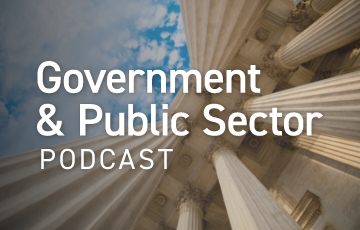Economic uncertainty and constraints are recurring challenges that state, local, tribal and not-for-profit organizations face. Cherry Bekaert and our team of subject matter experts (many of whom have walked in your shoes serving the public) are here to help you better understand your true cost, revealing insights that will help you plan for a sustainable economic future, and save you time so that you can stay focused on the bigger picture.
To guide you forward, we’ve put together these FAQs in the spirit of spreading information and understanding on the cost allocation plan and indirect cost rate concepts.
Basic Questions
What are cost allocations?
Cost allocation is the identification and categorization of expenses to various business activities, individuals, departments, projects, etc.
An allocation process helps organizations and agencies fairly distribute costs, assess the organization’s profitability and make future planning easier. It also ensures a more accurate financial assessment of performance and decision-making.
What is a cost allocation plan?
A cost allocation plan is the documentation of an organization’s process of assigning expenses. An organization can choose to create several plans based on their ongoing projects or programs and the different allocation methods they’ve chosen to use.
When should an agency obtain a cost allocation plan?
All agencies that have multiple service lines should always have a cost allocation plan.
What are indirect costs in a grant?
Indirect costs are expenses that do not directly relate to the project or program that is funded by the grant. These overhead costs can include rent, utilities, administrative staff wages, advisory services, etc.
Negotiated Indirect Cost Rate Agreement (NICRA) Questions
What is a cognizant agency and how is it determined?
The cognizant agency is the agency providing the largest sum of funding. Note that your cognizant agency remains the same until funding from another agency is greater for five years, at which point your cognizant would change.
Once you have a Negotiated Indirect Cost Rate Agreement (NICRA) approved with your cognizant agency, does it apply to grants from other federal agencies?
Yes, once you’ve received a NICRA, all other federal and state agencies must accept it, even if you are a subrecipient. See 2 CFR Part 200 Subpart E (200.414).
What’s the difference between an “Admin Cap” and the use of a NICRA?
The NICRA represents agency-wide indirect cost, such as finance, HR, etc., whereas the Admin Cap is defined as overhead to programs, e.g., supervisors overseeing a program(s). For example, a finance analyst that is responsible for overseeing a few grants (20% of their time) but spends the rest of their time (80%) processing payroll, 20% falls under the Admin Cap, and the remaining 80% would be part of the NICRA.
When an Admin Cap is present, refer to the Notice of Funding Availability (NOFA) to determine if a NICRA can be used in addition to the Admin Cap. If not specifically and implicitly stated that a NICRA can’t be used/is unallowed, then a NICRA is allowable in addition to the Admin Cap (i.e., it has to spell it out).
Can you go back two years to claim indirect cost on past grants if you didn’t claim indirect cost to begin with?
Yes, and if you didn’t have a NICRA for those two years, you can still calculate one and apply it.
Can your NICRA be used as the grants’ match component?
Yes, per OMB guidelines: 2 CFR Part 200, 306.7 (C) Unrecovered indirect costs, including indirect costs on cost sharing or matching may be included as part of cost sharing or matching only with the prior approval* of the Federal awarding agency. Unrecovered indirect cost means the difference between the amount charged to the Federal award and the amount which could have been charged to the Federal award under the non-Federal entity's approved negotiated indirect cost rate.
Note
In order to use your NICRA as your match, it is required to notify the funder. The funder does not have the authority to deny use for match based on the guidelines.
Even if your grant disallows indirect cost, your NICRA can still be used as match.
What if my cognizant says they don’t have to negotiate because I have less than $35M in direct federal funding?
If you have less than $35M in direct federal funding as a government agency or $10M as a nonprofit, you are not required to submit an Indirect Cost Rate Proposal (ICRP) to your cognizant.
However, you are required to prepare the submission packet, including your rate, and it can be “kept on the shelf.” If a funder requires a negotiated rate, they must negotiate directly with you or accept the existing submission packet. They cannot force you to use de minimis; they must negotiate.
Will application of the NICRA take funding away from the program?
This is a common concern and misconception. Indirect cost is incurred to run a program regardless from where that cost is funded. For most agencies, these indirect costs are subsidized by the General Fund (taxpayer dollars).
It’s important to understand that indirect cost exists and may be covered by program funding or the General Fund. An agency can choose to apply the full NICRA or any percentage up to that rate, which allows the agency to make the strategic decision to fully apply the NICRA to the grant or knowingly subsidize from the General Fund.
Rate Negotiation Questions
How long does the negotiation process typically take?
Three to six months, but the cognizant is required to negotiate within six months.
Can your rate change year over year?
The indirect cost rate should be fairly consistent without the carry forward adjustment. The carry forward is what brings variance.
How often do you have to negotiate a rate?
Annually, however OMB guidelines allow for a one-time extension of a current NICRA for a period of up to four years. The extension will be subject to review and approval of the cognizant agency.
Can a cognizant tell me my rate seems too high?
No, the rate is based on audited financial statements, and they don’t have the authority to change the rate. They must accept the rate calculated as long as indirect costs included in the pool are deemed allowable by 2 CFR Part 200.
Often, perceptions are that a high rate is an indication of poor management and efficiency, therefore agencies are less inclined to negotiate the rate out of fear that the cognizant won’t approve. This is a common misconception. The rate is based on audited financials and the cognizant is more likely to approve because the agency has demonstrated an understanding of their true cost.
Does having a NICRA make us more likely to win awards?
Yes, because it demonstrates awareness of direct and indirect cost so that you are more likely to utilize a grant to its fullest potential and have a successful program outcome. Even if your full indirect cost is not reimbursable due to grant restrictions, it informs the grantor you are aware of the subsidy necessary to fulfill the expectations of the grant.
Cost Plan Questions
What is the most common area of the cost plan where organizations “leave money on the table”?
Bank fees — many agencies do not include them.
In many cases banking fees are offset from interest earned in the bank accounts so there is never an actual payment to the bank for these fees, resulting in the absence of a line-item cost in the budget. However, this cost is allowable and should be added to the cost that is spread. Also, agencies often aren’t aware that they can include the interest charged on loans/bonds or the attorney fees charged when setting up these loans.
For smaller organizations, is it better for them to just get the 10% de minimis instead of doing a cost plan when you factor in time and cost of creating a plan?
It is our opinion that it is NEVER better to get the 10% de minimis. Smaller agencies can calculate a cost plan fairly simply without a lot of effort and realize a 30% – 50% indirect cost rate.
What is matching/cost sharing?
Simply put, “match” is the non-federal share of costs that the grantee or the grantee’s partners are required to contribute to accomplish the purposes of the grant.
Funders have various reasons to require match. The primary reason is to share the costs of various government programs across jurisdictions or with the private sector. Funders sometimes structure match requirements to promote sustainability of projects past the life of the grant program.
Matching funds include:
- Non-federal public or private funds
- Funds that are not used as match for any other federal program
- Unrecovered indirect costs
- Either an actual expenditure (cash) or a virtual cost (in-kind contribution)
Your Guide Forward
The Government & Public Sector team at Cherry Bekaert consists of committed experts who provide valuable insights and support to assist state and local government agencies, as well as not-for-profit organizations. Our specialists can help optimize business operations, making it possible to obtain your financial objectives. If you need assistance with the cost allocation process or negotiating an indirect rate, reach out to us today.





